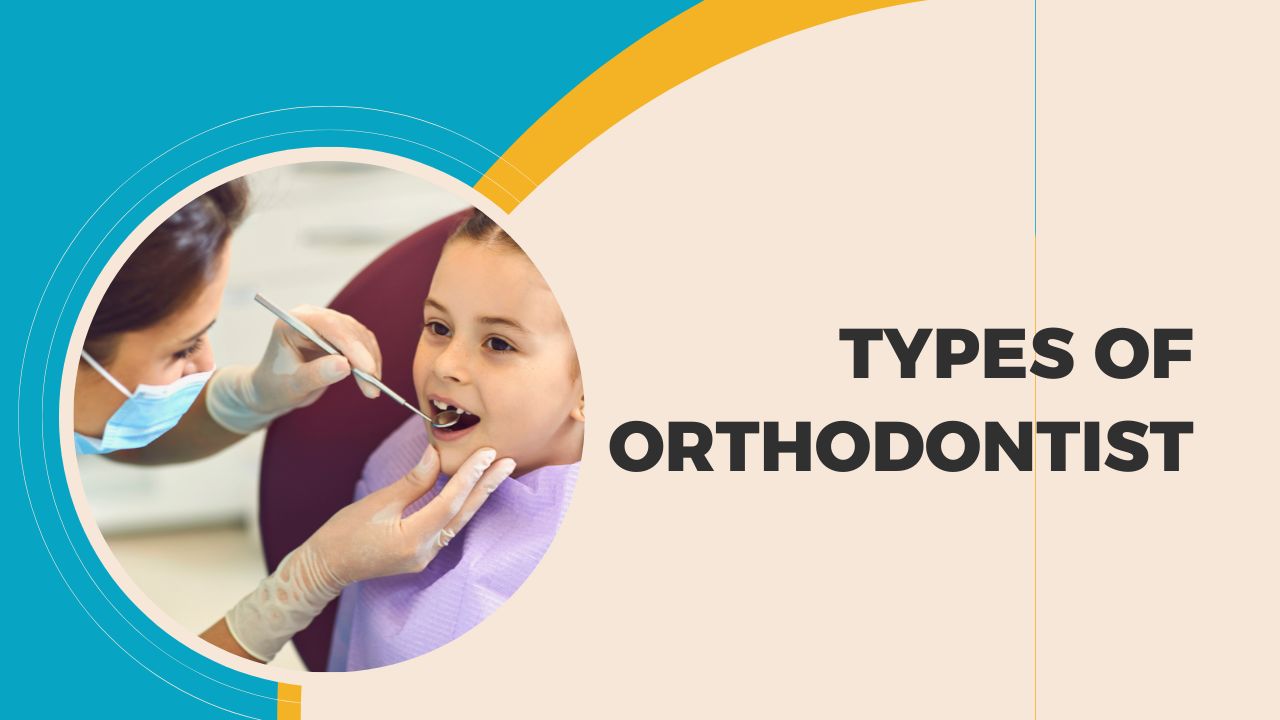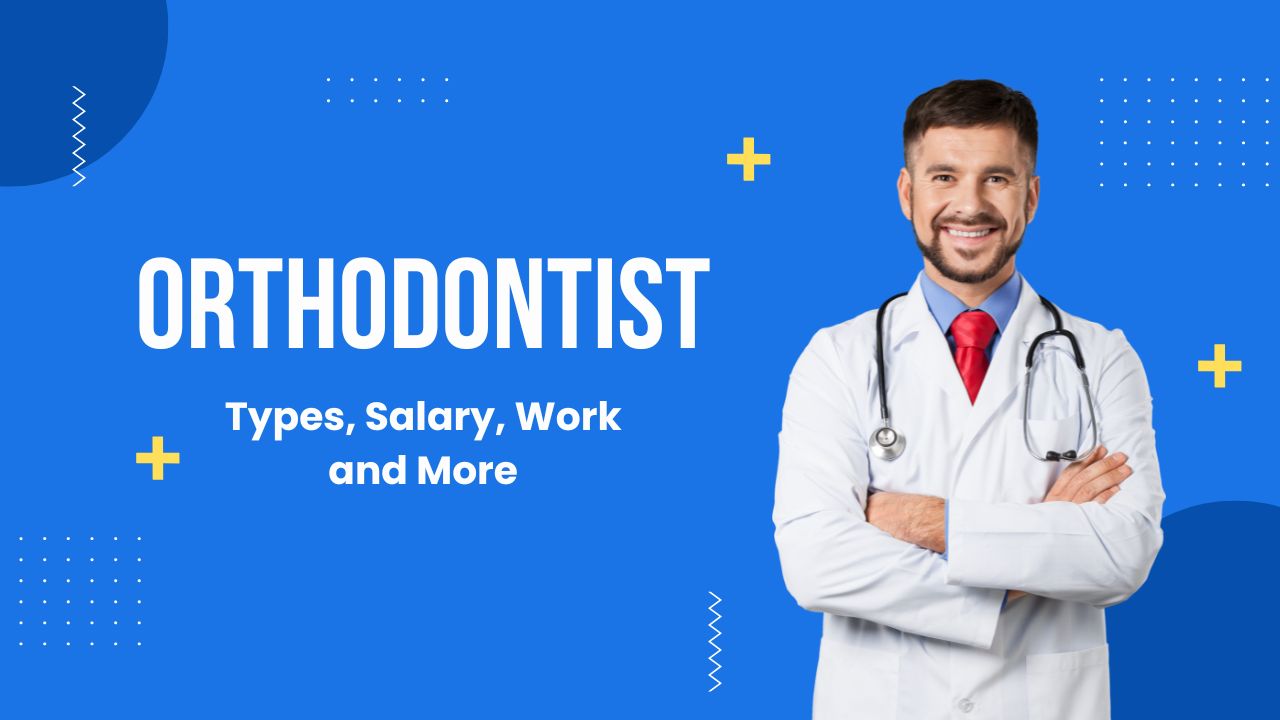Orthodontist – Types, Salary, Work and More in 2024
An orthodontist is a dental specialist trained in diagnosing, preventing, and treating malocclusions or improper bites.
Orthodontic treatment can help correct misaligned teeth, jaws, and facial structure and improve oral health and appearance.
Orthodontists undergo extensive training beyond that of a general dentist. They typically complete an undergraduate degree and four years of dental school to become a dentist.
After dental school, they undergo two to three years of specialized training in an orthodontic residency program.
During their residency, orthodontists receive advanced education in orthodontics, including braces, retainers, and other dental appliances to straighten teeth and correct bites.
They also learn about using orthodontic technology, such as 3D imaging and digital modeling, to diagnose and plan treatment.
Orthodontic treatment can address various issues, including overcrowded or crooked teeth, gaps between teeth, overbites, underbites, and crossbites.
Orthodontists may correct these issues by using braces, clear aligners, retainers, or other dental appliances.
Highest Paying Jobs without A Degree in India
Orthodontic treatment can have numerous benefits beyond just improving the appearance of your smile. Correcting a misaligned bite can improve your ability to chew, speak, and breathe properly.
It can also help improve your oral health by making brushing and flossing your teeth more accessible, reducing your risk of tooth decay and gum disease.
If you are considering orthodontic treatment, finding an experienced and qualified orthodontist who can provide you with the personalized care you need is crucial.
Your orthodontist will work with you to develop a treatment plan that meets your unique needs and goals and will provide ongoing care and support throughout your treatment.

Types of Orthodontists?
Several different types of orthodontists specialize in different areas of orthodontics. Some of the most common types include:
Traditional Orthodontists – These are the most common type of orthodontists who treat patients of all ages with traditional braces, clear aligners, and other orthodontic appliances.
Pediatric Orthodontists – These orthodontists specialize in the treatment of children and young adults, and have additional training in child psychology and development to help make treatment more comfortable and practical for young patients.
Adult Orthodontists – These orthodontists focus on treating adult patients with unique orthodontic needs or concerns, such as gum disease or jaw pain.
Surgical Orthodontists – These orthodontists work with oral and maxillofacial surgeons to correct severe malocclusions or skeletal problems that cannot be corrected with traditional orthodontic treatment alone.
Lingual Orthodontists – These orthodontists specialize in lingual braces, which are braces that are placed on the back side of the teeth, making them virtually invisible.
Orthodontic Prosthodontists – These orthodontists specialize in using dental implants, bridges, and other prosthetic devices to correct bite problems and improve the function and appearance of the teeth.
TMD Orthodontists specialize in treating temporomandibular joint disorders (TMD), which can cause jaw pain, headaches, and other symptoms.
Choosing the correct type of orthodontist for your needs will depend on your orthodontic concerns and goals. Researching and choosing an orthodontist with the experience and training necessary to provide you with the best possible care is essential.
How to become an Orthodontist?
Becoming an orthodontist requires a significant amount of education and training. Here are the steps to becoming an orthodontist:
Obtain a Bachelor’s Degree: To become an orthodontist, you must first obtain a bachelor’s degree from an accredited college or university.
While no specific major is required, most students pursue a degree in biology, chemistry, or a related field.
Attend Dental School: After completing your undergraduate degree, you must attend dental school and earn a Doctor of Dental Medicine (DMD) or Doctor of Dental Surgery (DDS) degree.
The dental school typically takes four years to complete and includes classroom instruction and clinical practice.
Complete an Orthodontic Residency Program: After completing dental school, you must complete a specialized orthodontic residency program that typically lasts two to three years.
During this time, you will receive advanced orthodontics training, including braces, clear aligners, and other orthodontic appliances.
Obtain Licensure: After completing your orthodontic residency program, you must obtain a license to practice dentistry in your state.
Licensure requirements vary by state but typically involve passing a written and clinical examination.
Become Board Certified: While board certification is not required to practice as an orthodontist, it can demonstrate your expertise and commitment to the field.
To become board certified, you must pass a rigorous written and clinical examination administered by the American Board of Orthodontics.
Overall, becoming an orthodontist requires a significant amount of time and dedication, but it can be a rewarding career that allows you to improve the oral health and appearance of your patients.

What is the salary of an Orthodontist in India?
The salary of an orthodontist in India can vary depending on various factors such as location, experience, and type of practice.
An orthodontist in India can earn between ₹800,000 to ₹2,000,000 annually. However, some highly experienced and successful orthodontists can earn even more than that.
The salary of an orthodontist may also vary based on their practice types, such as working in a private clinic or a hospital.
It’s important to note that the salary of an orthodontist in India may be lower than in some other countries due to differences in healthcare systems and living standards.
Orthodontist specialist
An orthodontist specialist is a dentist who has received additional education and training in orthodontics. Orthodontists specialize in preventing, diagnosing, and treating dental and facial irregularities, including crooked teeth, overcrowded teeth, and misaligned bites.
To become an orthodontist specialist, a dentist must first complete dental school and obtain a degree in dentistry.
After dental school, they must complete a specialized orthodontic residency program that typically lasts two to three years.
During this residency program, orthodontic specialists receive advanced orthodontics training, including braces, clear aligners, and other orthodontic appliances.
Orthodontist specialists use various techniques and appliances to straighten teeth and improve the alignment of the jaws.
Some of the most common orthodontic treatments include braces, clear aligners, and retainers.
Orthodontists work closely with other dental and medical professionals to provide comprehensive patient care and ensure the best possible outcomes.
FAQ
What does an orthodontist do?
An orthodontist is the dental specialist who focuses on preventing, diagnosing, and treating dental and facial irregularities.
They use various techniques and appliances to correct problems, such as crooked teeth, overcrowded teeth, and misaligned bites. Here are some of the specific things an orthodontist does:
Evaluate and diagnose orthodontic problems: Orthodontists use various tools and techniques to evaluate and diagnose orthodontic problems, such as taking x-rays, examining teeth and gums, and assessing jaw alignment.
Develop a treatment plan: Based on their diagnosis, orthodontists develop a customized treatment plan for each patient, taking into account their unique needs and goals.
Use braces and other appliances: Orthodontists use a variety of braces and appliances to gently move teeth into their proper position, including traditional metal braces, clear braces, lingual braces, and clear aligners.
Monitor progress: Orthodontists closely monitor their patient’s progress throughout treatment and make adjustments as needed to ensure the best possible outcomes.
Provide follow-up care: After treatment is complete, orthodontists provide follow-up care to ensure that teeth remain in their proper position and that patients maintain good oral health.
Overall, orthodontists play a critical role in helping patients achieve healthy, beautiful smiles that can improve their confidence and overall quality of life.
Jobs with the Highest Job Satisfaction in India
Is an orthodontist different than a dentist?
Yes, an orthodontist is different from a dentist. While orthodontists and dentists have completed dental school and are trained to care for your teeth and gums, they have different areas of specialization and focus on different aspects of oral health.
Dentists provide general oral health care services, including preventive care, such as cleanings and check-ups, and treatment of common dental problems, such as cavities, gum disease, and tooth decay. They may also perform cosmetic dentistry procedures like teeth whitening and veneers.
Orthodontists, on the other hand, specialize in diagnosing, preventing, and treating dental and facial irregularities, such as crooked teeth, overcrowded teeth, and misaligned bites.
They use various techniques and appliances to correct these problems, including braces, clear aligners, and retainers.
While dentists and orthodontists can help you maintain good oral health, orthodontists have additional specialized training to provide more advanced care for specific dental and facial irregularities.
If you have concerns about your teeth or jaw alignment, you may need to see an orthodontist for specialized care.
Is an orthodontist higher than a dentist?
In terms of education and training, both orthodontists and dentists have completed dental school and have the same level of education.
However, orthodontists have additional specialized training beyond dental school that allows them to provide more advanced care for specific dental and facial irregularities.
According to the Bureau of Labor Statistics in the United States, the median annual wage for orthodontists is higher than that of general dentists.
This may be because orthodontic treatment often requires more time and specialized care than other dental procedures, and orthodontists typically charge higher fees for their services.
That being said, both dentists and orthodontists play an essential role in maintaining good oral health, and both professions require a high level of skill and dedication.
The choice between seeing a dentist or an orthodontist depends on your oral health needs and concerns.
Is an orthodontist a doctor?
Yes, an orthodontist is a doctor. To become an orthodontist, one must first complete dental school and earn a degree in dentistry, which typically takes four years.
After that, an orthodontist must complete an additional two to three years of specialized orthodontics training, including coursework and clinical practice focused on the prevention, diagnosis, and treatment of dental & facial irregularities.
Upon completing their education and training, an orthodontist will receive a Doctor of Dental Medicine (DMD) or Doctor of Dental Surgery (DDS) degree, just like a general dentist.
However, an orthodontist has specialized training and expertise to provide advanced care for specific dental and facial irregularities, such as crooked teeth, overcrowded teeth, and misaligned bites. Therefore, an orthodontist is a doctor who specializes in orthodontics.
Does an orthodontist need MBBS?
No, an orthodontist does not need to have an MBBS degree. MBBS (Bachelor of Medicine, Bachelor of Surgery) is a medical degree required to become a medical doctor.
However, to become an orthodontist, one must first complete a dental degree program (either a Doctor of Dental Medicine or a Doctor of Dental Surgery degree) and then complete additional specialized training in orthodontics.
After completing their dental degree, aspiring orthodontists usually complete a residency program in orthodontics, which can take 2-3 years.
During this residency program, they receive specialized training in diagnosing, preventing, and treating dental and facial irregularities.
Upon completing their training, they become eligible for certification by the American Board of Orthodontics or a similar certification board in their country.
In summary, to become an orthodontist, one must complete a dental degree program and additional specialized training in orthodontics, but an MBBS degree is not required.
Is BDS an orthodontist?
BDS (Bachelor of Dental Surgery) is a degree that is required to become a dentist, but it is not sufficient to become an orthodontist.
To become an orthodontist, one must first complete a BDS degree (or an equivalent dental degree) and then complete additional specialized training in orthodontics.
After completing their BDS degree, aspiring orthodontists typically complete a residency program in orthodontics, which can take 2-3 years.
During this residency program, they receive specialized training in diagnosing, preventing, and treating dental and facial irregularities.
Upon completing their training, they become eligible for certification by the American Board of Orthodontics or a similar certification board in their country.
In summary, while a BDS degree is a necessary first step toward becoming an orthodontist, additional specialized training in orthodontics is required to become a certified orthodontist.
What rank is an orthodontist?
Regarding the rank of orthodontists within the field of dentistry, orthodontists are specialists who focus on the prevention, diagnosis, and treatment of dental and facial irregularities, such as crooked teeth, overcrowded teeth, and misaligned bites. Orthodontists have completed dental school and then additional specialized training in orthodontics.
Orthodontists are essential in maintaining good oral health and can provide advanced care for specific dental and facial irregularities. They work in various settings, including private practices, hospitals, and academic institutions.
What is the highest salary for an orthodontist in India?
The salary of an orthodontist in India can vary depending on various factors, such as location, experience, and type of practice.
According to thr PayScale, the average annual salary for an orthodontist in India is around INR 1.4 million (approximately USD 19,000).
However, salaries can range from INR 700,000 to INR 3.5 million (approximately USD 9,500 to USD 47,500) per year, depending on various factors.
It’s worth noting that these figures are based on self-reported data and may not accurately reflect the salary of all orthodontists in India.
Additionally, the salary of an orthodontist can also depend on the type of practice they are employed in, such as a private practice, hospital, or academic institution.
Is an orthodontist harder than a dentist?
Both becoming an orthodontist and a dentist require a significant amount of education, training, and dedication.
However, it is difficult to say whether one is harder than the other as the requirements and challenges of each profession differ.
Dentists provide a wide range of oral healthcare services, including teeth cleaning, filling cavities, and performing other basic dental procedures.
To become a dentist, one must complete a Bachelor of Dental Surgery (BDS) or a Bachelor of Dental Medicine and Surgery (BDS) degree program, which typically takes four to five years.
After completing the degree, a dentist must pass a licensure exam to obtain a dental license to practice.
To become an orthodontist, one must first complete a dental degree program (either a Doctor of Dental Medicine or a Doctor of Dental Surgery degree) and then complete additional specialized training in orthodontics.
After completing dental school, an aspiring orthodontist typically completes a residency program in orthodontics, which can take 2-3 years.
During this residency program, they receive specialized training in diagnosing, preventing, and treating dental and facial irregularities, such as crooked teeth, overcrowded teeth, and misaligned bites.
Both professions require a lot of hard work, dedication, and a commitment to lifelong learning to stay up-to-date with the latest advancements in dental care.
Ultimately, the difficulty of each profession may be subjective and depend on the individual’s strengths, interests, and career goals.
Is orthodontist a good career?
Orthodontics can be a rewarding and fulfilling career for those interested in dental health and aesthetics.
As an orthodontist, you would focus on correcting the alignment and position of teeth and jaws, using braces, aligners, and other orthodontic appliances to improve a patient’s bite, speech, and appearance.
There are several factors that can make orthodontics a good career choice. For one, the demand for orthodontic services will likely remain strong as more people seek treatments to improve their dental health and appearance.
Additionally, orthodontists can earn a good salary, with the median annual wage for orthodontists in the United States being over $200,000.
However, becoming an orthodontist requires significant education and training, including a four-year dental school program and a two- to three-year residency in orthodontics.
This can be a significant investment of time and money. Additionally, as with any healthcare profession, orthodontics can be emotionally and physically demanding, requiring long hours and close attention to detail.
Overall, whether or not orthodontics is a promising career for you depends on your interests, strengths, and goals. If you are passionate about improving dental health and enjoy working with patients to achieve their goals, orthodontics may be a rewarding career path.
Is studying orthodontist hard?
Yes, studying to become an orthodontist can be challenging and requires significant dedication and hard work. It typically involves several years of rigorous academic coursework and clinical training.
To become an orthodontist, you must first earn a degree in dentistry, which typically takes four years to complete.
After that, you will need to complete an additional two- to three-year residency program in orthodontics, during which you will receive specialized training in diagnosing, preventing, and treating dental & facial irregularities.
During your orthodontic residency, you will be required to complete significant clinical work, treating patients under the guidance of experienced orthodontists.
You will also need to pass licensing exams and meet other requirements to become licensed to practice as an orthodontist.
In addition to the academic and clinical demands of orthodontic training, you must develop strong communication and interpersonal skills to work effectively with patients and other healthcare professionals.
Studying to become an orthodontist can be challenging, but for those passionate about the field, the rewards of helping patients achieve healthy, beautiful smiles can make the hard work worthwhile.
Is an orthodontist a stressful job?
Like any healthcare profession, being an orthodontist can be stressful at times. Additionally, orthodontists may face demanding work schedules, long hours, and a high volume of patients.
Orthodontists work with patients who may be experiencing discomfort or pain and are responsible for making critical decisions about the course of treatment.
However, the level of stress experienced by an orthodontist can vary depending on factors such as work environment, patient load, and personal coping strategies.
Some orthodontists may find ways to manage stress through self-care activities such as exercise, meditation, or seeking support from colleagues or mental health professionals.
It is also important to note that orthodontics can be a highly rewarding career, as orthodontists can improve their patient’s quality of life by helping them achieve healthy, functional bites and beautiful smiles.
Many orthodontists find satisfaction in developing relationships with their patients and seeing the positive outcomes of their work.
Ultimately, whether or not orthodontics is a stressful job will depend on the individual orthodontist and their ability to manage the demands of their work while prioritizing self-care and maintaining a healthy work-life balance.
Is it hard to get a job as an orthodontist?
While the job market for orthodontists can vary depending on location and demand, overall, it is not necessarily hard enough to get a job as an orthodontist.
In fact, according to the Bureau of Labor Statistics, the employment of orthodontists is projected to grow 7% from 2020 to 2030, which is faster than the average for all occupations.
That being said, competition for orthodontic positions may be high in certain areas or for certain practices.
For example, orthodontists may face more competition in urban areas with a high concentration of dental practices, or in areas with lower demand for orthodontic services.
In addition to the competition, orthodontists may need to meet specific qualifications or licensure requirements to practice in their desired location. This may include passing licensing exams or obtaining specialty certifications.
Overall, while the job market for orthodontists may have its challenges, with the right qualifications, skills, and dedication, it is possible to build a successful and rewarding career in orthodontics.
What are the risks of being an orthodontist?
Like any profession, there are some risks associated with being an orthodontist. Here are a few potential risks to consider:
Exposure to disease: Orthodontists work near patients, which may expose them to infectious diseases. To minimize this risk, orthodontists wear personal protective equipment, such as gloves and masks, when treating patients.
Repetitive strain injuries: Orthodontists often perform repetitive tasks like adjusting braces or working with dental appliances. Over time, this can lead to repetitive strain injuries, such as carpal tunnel syndrome or tendinitis.
Exposure to radiation: Orthodontists may be exposed to radiation when taking X-rays of patients. Orthodontists typically use lead aprons and other protective equipment to minimize this risk when taking X-rays.
Emotional stress: Orthodontists may experience emotional stress when working with patients with complex dental issues or experiencing pain or discomfort. Additionally, managing the demands of running a practice or working long hours can contribute to emotional stress.
Malpractice claims: As with any healthcare professional, orthodontists may face malpractice claims if a patient alleges that they were harmed due to the orthodontist’s actions or negligence.
Overall, while some risks are associated with being an orthodontist, many can be minimized through proper training, safety protocols, and other precautions.
Additionally, many orthodontists find their work to be rewarding and fulfilling, despite the challenges that come with the job.
Do you need maths to be an orthodontist?
Yes, orthodontics involves the use of mathematics in several ways. Orthodontists use math to analyze and diagnose problems related to dental and facial irregularities, develop treatment plans, and design and fabricate appliances such as braces and retainers.
Some examples of mathematical concepts commonly used in orthodontics include geometry, trigonometry, calculus, and physics.
For example, orthodontists use geometry to analyze the spatial relationships between teeth and their positions in the jaw and trigonometry to calculate angles and determine how teeth should be moved.
In addition, orthodontists also use computer software that employs mathematical algorithms to simulate tooth movements and plan treatments, and digital imaging technologies that rely on mathematical principles to create accurate representations of teeth and jaws.
So, while not all orthodontists may use mathematics daily, a solid understanding of math is essential for success in this field.
How many hours do orthodontists work a day?
The number of hours an orthodontist works daily can vary depending on their practice and personal preferences. In general, however, most orthodontists work full-time schedules, which typically consist of eight to ten hours per day.
Some orthodontists may choose to work longer hours, especially if they are trying to build their practice or accommodate the needs of patients who require more extensive or complex treatments.
Others may prefer to work shorter hours, particularly if they have other responsibilities or interests outside their practice.
Overall, the specific number of hours that an orthodontist works per day can vary depending on various factors, but most work full-time schedules.
It is also worth noting that orthodontists may work irregular or flexible schedules, mainly if they are part of a group practice or work in multiple locations.
Some orthodontists may work evening or weekend hours to accommodate patients who have busy schedules during the day.
What is an orthodontist degree called?
An orthodontist is a type of dentist specializing in diagnosing, preventing, and treating dental and facial irregularities.
To become an orthodontist, you must first complete a degree in dentistry called a Doctor of Dental Medicine (DMD) or Doctor of Dental Surgery (DDS) degree.
After completing a dental degree, aspiring orthodontists typically complete a specialized postgraduate program in orthodontics, which leads to a Master of Science in Dentistry (MSD) or a Doctor of Science in Dentistry (DScD) degree.
These programs typically take an additional 2-3 years of full-time study, focusing specifically on diagnosing and treating dental and facial irregularities using braces, retainers, and other orthodontic appliances.
Once an orthodontist has completed their formal education and training, they must also obtain a license to practice in their state or country.
This typically involves passing a series of written and clinical exams to demonstrate their knowledge and skills in orthodontics.
What qualification does an orthodontist have?
To become an orthodontist, one must complete several years of education and training beyond a bachelor’s degree. Here are the general qualifications required to become an orthodontist:
Bachelor’s degree: The first step to becoming an orthodontist is to earn a bachelor’s degree from an accredited college or university.
No specific major is required, but most students choose to major in a science-related field, such as biology or chemistry.
Dental school: After completing a bachelor’s degree, students must attend dental school and earn a Doctor of Dental Medicine (DMD) or Doctor of Dental Surgery (DDS) degree. This typically takes four years of full-time study.
Orthodontic residency: Aspiring orthodontists must complete an orthodontic residency program after dental school.
This typically takes an additional two to three years of full-time study and includes clinical training in orthodontic diagnosis and treatment.
Licensure: Once an orthodontist has completed their education and training, they must obtain a license to practice in their state or country.
This typically involves passing a series of written and clinical exams to demonstrate their knowledge and skills in orthodontics.
Becoming an orthodontist requires several years of education and training, including a bachelor’s degree, dental school, an orthodontic residency program, and licensure.
How do I start an orthodontist career?
Becoming an orthodontist requires several years of education and training beyond a bachelor’s degree. Here are the general steps to start an orthodontist career:
Obtain a bachelor’s degree: The first step to becoming an orthodontist is to earn a bachelor’s degree from an accredited college or university.
While no specific major is required, most students choose to major in a science-related field, such as biology or chemistry.
Attend dental school: After completing a bachelor’s degree, students must attend dental school and earn a Doctor of Dental Medicine (DMD) or Doctor of Dental Surgery (DDS) degree. This typically takes four years of full-time study.
Complete an orthodontic residency: After completing dental school, aspiring orthodontists must complete an orthodontic residency program.
This typically takes an additional two to three years of full-time study and includes clinical training in orthodontic diagnosis and treatment.
Obtain licensure: Once you have completed your education and training, you must obtain a license to practice in your state or country.
This typically involves passing a series of written and clinical exams to demonstrate your knowledge and skills in orthodontics.
Gain work experience: After becoming licensed, it is common for newly graduated orthodontists to gain work experience by working as an associate in an established orthodontic practice or opening their own practice.
Overall, becoming an orthodontist requires several years of education and training and a commitment to ongoing learning and professional development.
If you want to pursue a career as an orthodontist, you should start by obtaining a bachelor’s degree and then apply to dental school. You can follow the steps outlined above to become an orthodontist.
Investment Banker | Chartered Accountant | IT Manager | Dentist | Software Architect | Data Scientist | Psychiatrist | Physician | Surgeon







